Below is a web map showing the connections between the key pages of the Hive social networking site:
Below is a web map showing the connections between the key pages of the Hive social networking site:
Here is a gallery of the critical pages of Hive. Click on any image to enlarge:
Here is the Gantt Chart of the first phase of our project, in which major tasks have been performed successfully:
Further tasks we need to perform in the next phase are allocated to project team members and the following gantt chart is the time scale of those tasks:
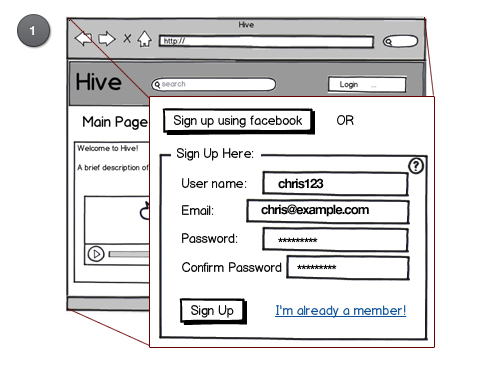
Chris enters Hive, fills the registration form on the page, and click the sign up button to become member of Hive.
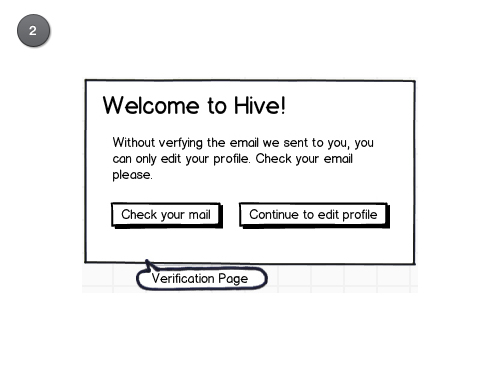
Chris needs to go to his mailbox and read the verification email and confirm it in order to make his Hive account activated.
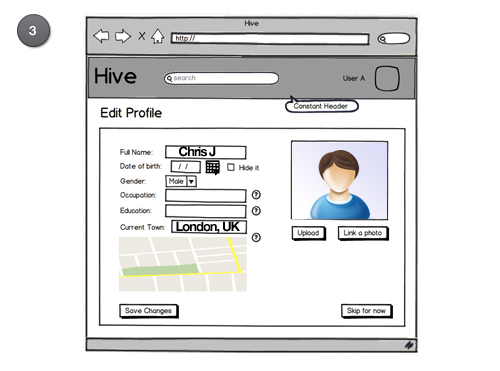
After signing up and passing the verification pop-up, Chris enters to edit page automatically. He decides to provide his name, gender and location. But, not other information.
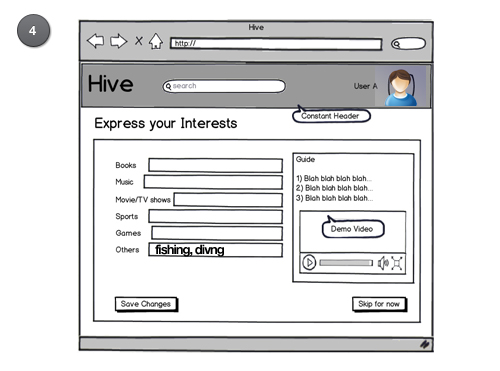
Next step and the most important part is this page, in which Chris can express his interests to get connected to a network he would like. He just writes 'fishing' and 'diving' in the form; but, he may express other interests later on.
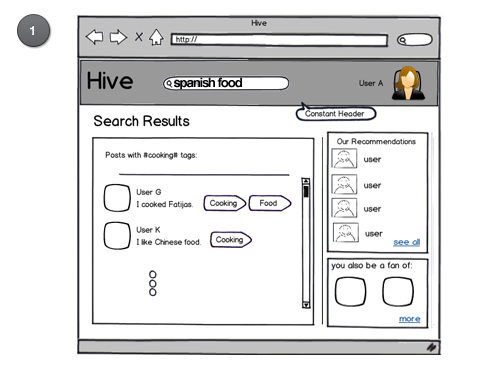
The first option for Elena is to search 'Spanish food' in the search bar which is always accessible in the constant header of Hive. By doing so, she enters the page result in which she can find all the people interested in spanish food or related interests. She gets recommendation on that page to become friend with people who like Spanish food and are most similar to her.
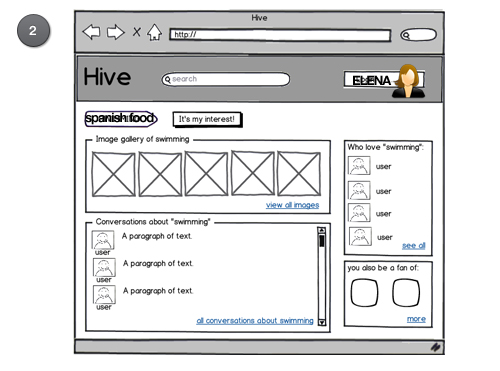
The second option for Elena is going to the specific page of the interest 'Spanish food' which is created when a user adds Spanish food to his interests. Here she can read all the conversation about it and find similar people to her who are interested in Spanish food. She can find other interests similar to Spanish food as well because Hive recommends her. Happy cooking Elena!
In the previous post we analysed Facebook, which is not only the most widely used social networking site, but also a perfect example of why Hive will make a good change in the world of social networking.
As a user, one of the most annoying features of Facebook is the chaotic timeline. More importantly, the majority of posts on my timeline cannot attract much of my attention. Although Facebook provides relatively fine-grained control of your timeline, it requires much management effort. Ironically, most of my closest friends agree on this problem with me; therefore they choose to be ‘silent’ on Facebook most of the time. As a result, I barely see their shares and thoughts.
Relationships on Facebook are the reflection of offline relationships, and this is one of the reasons why Facebook has become so successful. However, colleagues or school mates don’t necessarily share interests with you. In other words, Facebook cannot connect you with other users who are similar to you.
In order to demonstrate this observation, I developed a tool to analyse “like” information from Facebook users during easter. By calculating how many common likes you share with your friends, I can validate my assumption on this topic. Moreover, I will be able to know the ‘taste distance’ between my friends and me quantitatively.
All of our 4 group members participated in the analysis and we had similar results: Many of ours friends share hardly any common interests with us. Two charts will be given showing two of the user’s friends networks and the number of common likes between their friends.
Chart 1 shows that 65% of that user’s friends share less than 5 interests in common. 84% of his friends share no more than 10 commons with him. Only 3 have more than 25 common likes – that’s only 2 percent of his friends.
Chart 2 shows another user’s result. He has much more likes than the previous user. But it still shows very similar pattern in the chart. 61% of his friends have less than 5 interest in common with him, and 76% percent of his friends have less than 10 common interests with him. Only a limited number of his friends share many common interests with him. There is a number which also draws attention, out of his 600 friends, 97 of them haven’t added any interest information on Facebook.
It is also noted that, many users indeed add their interest information on Facebook. Taking myself as an example, my friends add average 130 likes on their pages. On the contrary, a portion of our friends haven’t added any likes into their profiles.
In conclusion, the analysis has shown the previous assumption that Facebook is not a place where friendships are based on interests.
On the other hand, because Facebook is not interest-centric, it could have resulted in inaccuracy of this analysis. For example, a user likes The Beatles, The kinks and his friends can also simply state he likes music in 60s. Essentially, these two users have very similar music taste but the analysis is not able to reflect it.
This brings other topics such as information structure and granularity control which an interest-centric SNS should work on.
Facebook is the most popular social network with 845 million users and allows users to register and create a profile. They can add other users as friends and then they can exchange messages and communicate with each other. Facebook is about having your real friends or people you know in a digital social network. Facebook gives the ability to the users to post on their wall about anything that is on their mind. This feature allows to the users to see what their friends thinking at the moment and then discuss about that instantly. Users can also share photos, so their friends can watch them, like them, or even comment them.
Facebook is trying to suggest to the users some other users that may know. Most common example is when Facebook suggest us a user that we have many common friends, so there is a high possibility that we already know each other, but we are not friends on Facebook.
When creating your Facebook profile at the beginning you can enter information such like what school you went, where you work, what are your interests and much more. For “X”, we could get a user’s information (if he gives us the permission) to get what his interests are and what he is tend to like so we can use this information to suggest him other users.
Pinterest is a web application for sharing interesting videos and photos. It borrows the idea of pining and board from real life. Users can create a board which is an abstract concept and pin images and videos on it. By pinning interesting things on boards, they are able to share these interesting items to their friends(followers). If a photo, for example, hits a user’s interest, they can repin it to their own board.
Users can pin both inside Pinterest and outside the application. Pinterest provides a “pin it” button that can be added to bookmark bar in the browser so when users find interesting photos or videos, by clicking the button, the images or vides are added to Pinterest seamlessly.
Our goal is to connect everyone in the world through the ‘things’ they find interesting. We think that a favourite book, toy, or recipe can reveal a common link between two people. [1]
This is the goal that is stated by the creators of Pinterest. With very limited short of time, Pinterest has indeed attract million users. [2] Not only the number of users has increased in a short of time, but also the referral traffic. According to a study, Pinterest now generates more referral traffic than Twitter. [3]
Moreover, Pinterest has arguably behaved even better than Facebook as an e-business platform. Since it has already be generating tens of millions of dollars in revenue through affiliate fees received from vendors who are refereed users from the service. [4]

GetGlue is a leading social network for entertainment. Users check-in and share what they are watching, listening to and reading with friends. Based on their check-ins they will receive points and may earn virtual stickers, receive fresh recommendations, and can earn discounts for over 25 media companies and other rewards from their favourite shows and movies. Moreover, once a month, users can request to have real versions of the stickers they earn online mailed to them for no cost. Stickers are typically mailed in batches of approximately 20. Watch the demo to check out what’s GetGlue about:
GetGlue is a recognized leader in social television and second screen applications. GetGlue has 2M users that checked-in over 100M times in 2011. 75 major networks and 10 movie studios use GetGlue to promote their shows and movies to fans.
Click here to watch an interview with Maya Harris, Director of business development of GetGlue, discussing about how GetGlue as a social media goes well with sports as an interest for sport fans.
GetGlue is available at GetGlue.com and via a variety of GetGlue apps. The GetGlue mobile app enables users to check-in to TV shows, movies, music and books, plus see what their friends are consuming in real-time. On GetGlue.com users can quickly build up their taste profile, get fresh suggestions every week, browse top lists and find taste neighbours.
Watch GetGlue iPhone app demo:
Look at the pictures of GetGlue iPhone app:
GetGlue partners include 20th Century Fox, The CW, AMC, ABC Family, Disney Theatrical, Discovery, ESPN, FOX, Food Network, Hachette, HBO, HGTV, MTV, MSNBC, Showtime, Penguin, PBS, Random House, Simon and Schuster, Syfy, Sony Pictures, Travel Channel, USA Network, Universal Pictures, and Warner Bros. theatrical.
According to Guardian, “GetGlue raises $12m funding round to fuel social TV ambitions”.
Meetup
Meetup is a web Site that helps you find groups that they may interest you and has approximately 8 million users. The way you search is by entering a word on a field and you declare what kind of group you want to search. For example you may want to search groups that have to do with movies. Also you have the option to enter your location, so the results will be near to you. If the result satisfies the user, then he can register to the group, so he can discuss with other members about the particular topic of the group. To register to a group you have to sign up either with your Facebook account or, by creating a new account using meetup’s sign up option.
The web site also gives you the ability to create a new group. To do that, you have to enter information such a name, a location, a purpose, a description, a theme etc.
There are lot of differences between Hive and meetup. The biggest one, is that with Hive you will have the ability to make friends with similar interests not only joining groups. Also Hive will suggest to the users some possible friends, so the user can find friends not only by searching. Another difference between these two is that in Hive, the user will have his own timeline to post and interact with his friends. This is not provided by meetup. Also because of the interest declaration by the users at the begging in Hive, a user can have invitations from other users. In contrast, in meetup this is one way only. Only users can find groups, and not the vice versa.
Concluding, there are more differences than similarities between these two Sites, so we believe that users that are not attracted by meetup will hopefully be, by Hive.
After some group discussion, we have chosen to proceed with idea 2 – an interest-based social networking site.
Why have we chosen this idea?
It is something that is missing from the world of online social networks. There are websites such as Facebook which primarily connects users with people they already know or people they may know, as well as sites which allow users to interact based on specific interests; however there appears to be nothing that combines the ‘social’ aspects with the ‘interest’ aspect.
There are very few platforms which allow a user to form ‘real’ friendships with people who share the same set of interests. Allowing users to make friends in this way could not only create an online network of people who can discuss, teach and inspire each other on the things they are passionate about, but also form friendships where meeting in real life can be possible without having to be a member of a dating website. The aim is to create truly ‘social’ network like Facebook but based on what people are interested in rather than whom people know.
Some initial ideas on website features
The site will use a keyword tagging system for interests – each user would essentially tag themselves with their interests. The site would:
Having a site such as this would eliminate the viewing of un-interesting posts from ‘friends’ which users barely speak to on sites such as Facebook, while retaining the aim of encouraging users to socialise.
Our next step is to do some background research to find sources of information that are useful and relevant to our project. In the next few posts, we will share with you what we have found, and we will continue to do this throughout the project as we find additional sources of information.